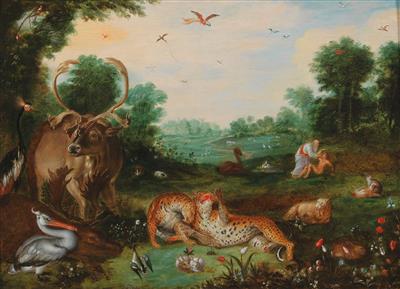Jan Brueghel II

(Antwerp 1601–1678)
A paradise landscape with a reindeer, a fallow deer, a pelican, and frolicking leopards, with the Creation of Adam in the background,
oil on panel, 33.5 x 46 cm, framed
Provenance:
Collection of Count Philipp Karl Wilhelm Michael von Seinsheim (1713–1761), cathedral provost of Speyer, canon of Cologne, Salzburg and Bamberg;
Private collection, Belgium
We are grateful to Klaus Ertz for confirming the authenticity of the present painting, which is accompanied by a certificate.
The motif of frolicking leopards recurs frequently in Jan Brueghel’s oeuvre, especially in his paradise landscapes, as does that of the antagonistic pair of a cat and dog engaged in amicable play. The motif of the reindeer, however, is unusual and unique. Brueghel must have been aware of its exoticism and singularity, as the animal is a focal point of the composition. It is unclear whether Brueghel actually saw the animal in real life, which in Europe was rarely to be found outside of Scandinavia, or whether he was inspired by a model in the form of a painting, drawing, or a print now unknown or lost. The great realism of the depiction speaks in favour of the first hypothesis. Reindeers were highly coveted collectibles kept in the zoos of the aristocracy – zoological equivalents to the chambers of curiosities – at the time, but the animals adapted to the Central European climate only with great difficulty. Landgrave Philip IV of Hesse-Kassel, who had established a famous zoo at Sababurg Castle as early as the sixteenth century, was confronted with this problem when his herd of reindeers imported from Lapland by ship arrived in the Reinhardswald heavily decimated and the remaining animals survived for only a few weeks. In Brueghel’s vicinity, the palace gardens in Brussels housed one of the most outstanding collections of exotic animals in Europe. This is where Brueghel most likely saw the reindeer. The present depiction is one of the earliest representations of this species, and the painting was most certainly commissioned by a member of the court. There seems to be no other explanation for the singularity of this rare animal in seventeenth-century Flemish painting.
The present painting also reveals how masterfully Jan Brueghel II understood how to combine traditional concepts with new forms and how to use his idiosyncratic style to create something that was not merely a copy of the old. Ertz dates the painting to the late 1620s. The painterly and vivacious brushwork is typical of Brueghel’s art from this period and reveals how Jan’s landscape style evolved independently at the time.
Esperto: Dr. Alexander Strasoldo
 Dr. Alexander Strasoldo
Dr. Alexander Strasoldo
+43-1-515 60-556
old.masters@dorotheum.com
25.04.2017 - 18:00
- Stima:
-
EUR 80.000,- a EUR 120.000,-
Jan Brueghel II
(Antwerp 1601–1678)
A paradise landscape with a reindeer, a fallow deer, a pelican, and frolicking leopards, with the Creation of Adam in the background,
oil on panel, 33.5 x 46 cm, framed
Provenance:
Collection of Count Philipp Karl Wilhelm Michael von Seinsheim (1713–1761), cathedral provost of Speyer, canon of Cologne, Salzburg and Bamberg;
Private collection, Belgium
We are grateful to Klaus Ertz for confirming the authenticity of the present painting, which is accompanied by a certificate.
The motif of frolicking leopards recurs frequently in Jan Brueghel’s oeuvre, especially in his paradise landscapes, as does that of the antagonistic pair of a cat and dog engaged in amicable play. The motif of the reindeer, however, is unusual and unique. Brueghel must have been aware of its exoticism and singularity, as the animal is a focal point of the composition. It is unclear whether Brueghel actually saw the animal in real life, which in Europe was rarely to be found outside of Scandinavia, or whether he was inspired by a model in the form of a painting, drawing, or a print now unknown or lost. The great realism of the depiction speaks in favour of the first hypothesis. Reindeers were highly coveted collectibles kept in the zoos of the aristocracy – zoological equivalents to the chambers of curiosities – at the time, but the animals adapted to the Central European climate only with great difficulty. Landgrave Philip IV of Hesse-Kassel, who had established a famous zoo at Sababurg Castle as early as the sixteenth century, was confronted with this problem when his herd of reindeers imported from Lapland by ship arrived in the Reinhardswald heavily decimated and the remaining animals survived for only a few weeks. In Brueghel’s vicinity, the palace gardens in Brussels housed one of the most outstanding collections of exotic animals in Europe. This is where Brueghel most likely saw the reindeer. The present depiction is one of the earliest representations of this species, and the painting was most certainly commissioned by a member of the court. There seems to be no other explanation for the singularity of this rare animal in seventeenth-century Flemish painting.
The present painting also reveals how masterfully Jan Brueghel II understood how to combine traditional concepts with new forms and how to use his idiosyncratic style to create something that was not merely a copy of the old. Ertz dates the painting to the late 1620s. The painterly and vivacious brushwork is typical of Brueghel’s art from this period and reveals how Jan’s landscape style evolved independently at the time.
Esperto: Dr. Alexander Strasoldo
 Dr. Alexander Strasoldo
Dr. Alexander Strasoldo
+43-1-515 60-556
old.masters@dorotheum.com
|
Hotline dell'acquirente
lun-ven: 10.00 - 17.00
old.masters@dorotheum.at +43 1 515 60 403 |
| Asta: | Dipinti antichi |
| Tipo d'asta: | Asta in sala |
| Data: | 25.04.2017 - 18:00 |
| Luogo dell'asta: | Vienna | Palais Dorotheum |
| Esposizione: | 15.04. - 25.04.2017 |
